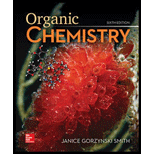
Concept explainers
(a)
Interpretation: The curved arrows are to be used to show the conversion of A and B to C.
Concept introduction: The Diels-Alder reactions are the
Curved arrows aid in determining the movement and flow of electrons in the reaction. The electrons that take part in the chemical reactions are shown by the curved arrows. An electronegative element in the reaction attracts electron toward it.
Half headed arrows are used to show the flow of single electrons, while the full headed arrow shows the movement of electron pairs.
(b)
Interpretation: The bonds that are broken and formed in the given reaction are to be identified.
Concept introduction: The bonds in the reactions are broken to form the new compounds. During the formation of products, new bonds are formed. The sum of bonds broken and bonds formed in the reactions are used to calculate the enthalpy change in the reaction.
(c)
Interpretation: The reaction is endothermic or exothermic is to be identified.
Concept introduction: The chemical reaction in which energy is released during the formation of products is known as exothermic reactions. The energy released during the reaction is denoted by
(d)
Interpretation: Entropy favors the reactants or products are to be identified.
Concept introduction: The change in Gibbs free energy, enthalpy and entropy is represented by
The change in Gibbs free energy describes the spontaneity of the reaction. The change in enthalpy describes the relative bond strength in the substance, whereas the change in entropy describes the randomness in the system.
(e)
Interpretation: The Diels-Alder reaction is to be classified as a substitution, elimination, or addition reaction.
Concept introduction: The substitution reactions involve the substitution or replacement of an atom or group of atoms in a compound by anotheratom or groups of atoms. In the substitution reactions, the replacement takes place by the break down of sigma bonds.
In elimination reaction, the formation of
Want to see the full answer?
Check out a sample textbook solution
Chapter 6 Solutions
Study Guide/solutions Manual For Organic Chemistry
- Identify the compound with the longest carbon - nitrogen bond. O CH3CH2CH=NH O CH3CH2NH2 CH3CH2C=N CH3CH=NCH 3 The length of all the carbon-nitrogen bonds are the samearrow_forwardIdentify any polar covalent bonds in epichlorohydrin with S+ and 8- symbols in the appropriate locations. Choose the correct answer below. Η H's+ 6Η Η Η Η Η Ηδ Η Ο Ο HH +Η Η +Η Η Η -8+ CIarrow_forwardH H:O::::H H H HH H::O:D:D:H HH HH H:O:D:D:H .. HH H:O:D:D:H H H Select the correct Lewis dot structure for the following compound: CH3CH2OHarrow_forward
- Rank the following compounds in order of decreasing boiling point. ннннн -С-С-Н . н-с- ННННН H ΗΤΗ НННН TTTĪ н-с-с-с-с-о-н НННН НН C' Н н-с-с-с-с-н НН || Ш НННН H-C-C-C-C-N-H ННННН IVarrow_forwardRank the following compounds in order of decreasing dipole moment. |>||>||| ||>|||>| |>|||>|| |||>||>| O ||>>||| H F H F H c=c || H c=c F F IIIarrow_forwardchoose the description that best describes the geometry for the following charged species ch3-arrow_forward
- Why isn't the ketone in this compound converted to an acetal or hemiacetal by the alcohol and acid?arrow_forwardWhat is the approximate bond angle around the nitrogen atom? HNH H Harrow_forwardOH 1. NaOCH2CH3 Q 2. CH3CH2Br (1 equiv) H3O+ Select to Draw 1. NaOCH2 CH3 2. CH3Br (1 equiv) heat Select to Edit Select to Drawarrow_forward
- Complete and balance the following half-reaction in acidic solution. Be sure to include the proper phases for all species within the reaction. S₂O₃²⁻(aq) → S₄O₆²⁻(aq)arrow_forwardQ Select to Edit NH3 (CH3)2CHCI (1 equiv) AICI 3 Select to Draw cat. H2SO4 SO3 (1 equiv) HO SOCl2 pyridine Select to Edit >arrow_forwardComplete and balance the following half-reaction in basic solution. Be sure to include the proper phases for all species within the reaction. Zn(s) → Zn(OH)₄²⁻(aq)arrow_forward
